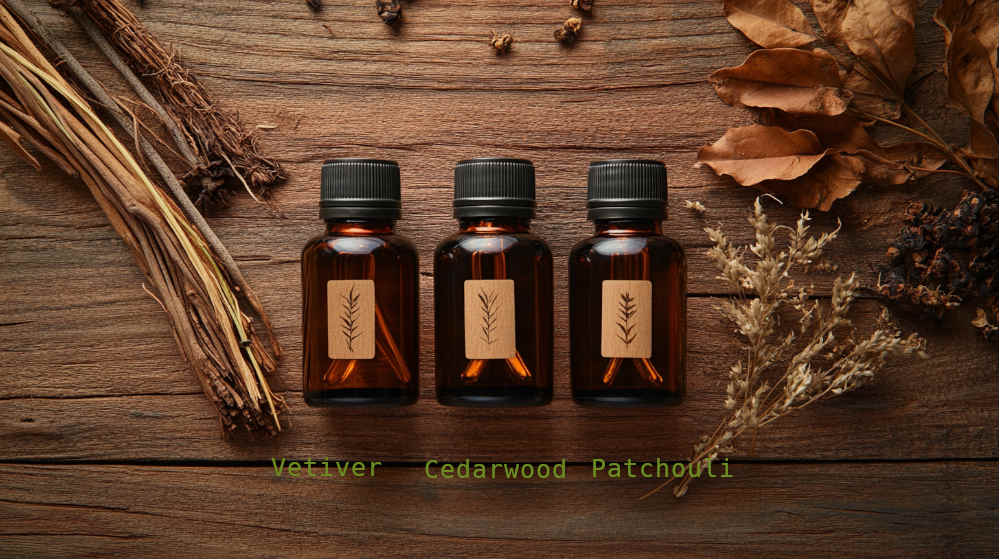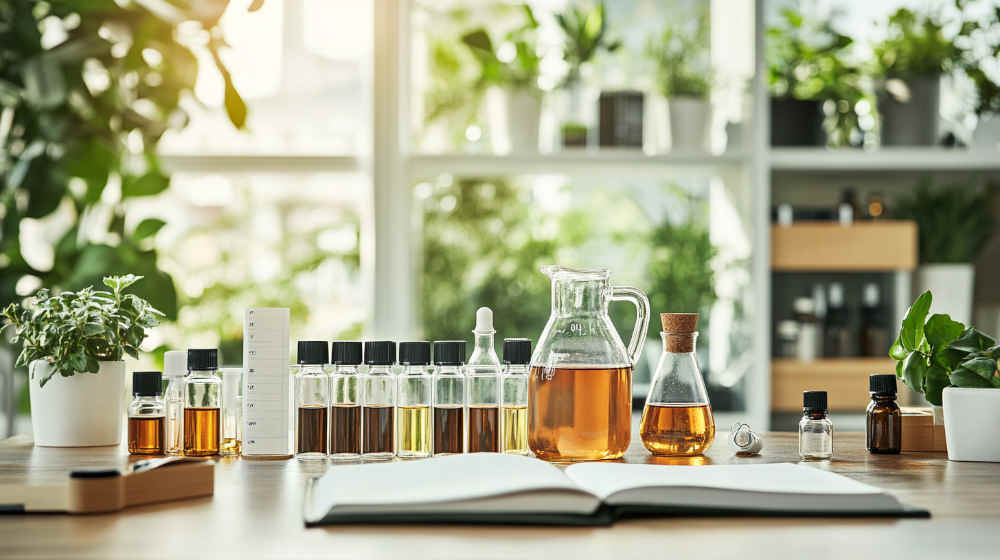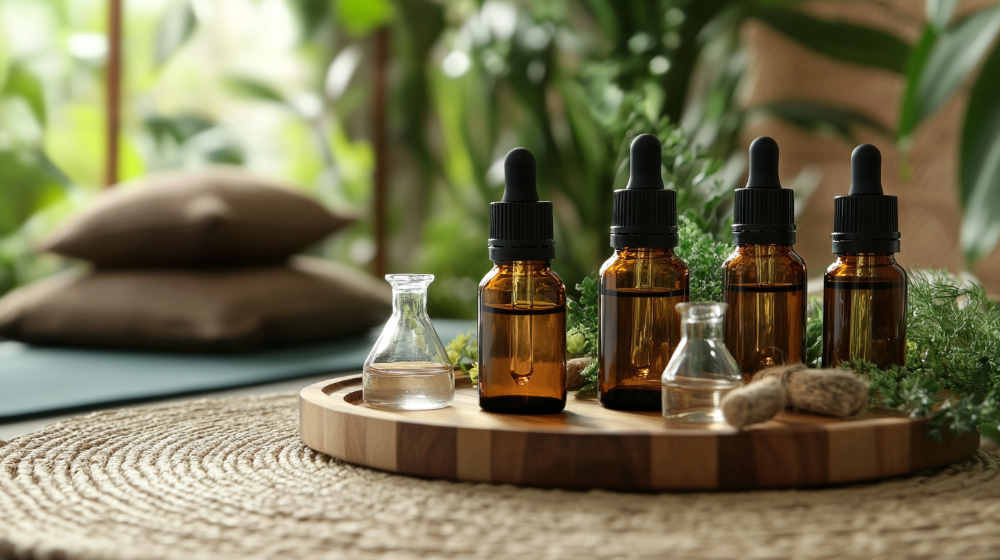Table of Contents - click here
TogglePresent-moment aromatherapy uses grounding essential oils like vetiver, cedarwood, and patchouli to anchor awareness in the now. Unlike relaxation oils, these therapeutic scents create stable alertness while reducing anxiety through direct limbic system activation. Professional blending enhances mindfulness practices naturally.
Anchoring in the Now
In our hyperconnected world, the simple act of truly being present has become revolutionary. We live bombarded by notifications, deadlines, and endless mental chatter that pulls us everywhere except where we actually are—right here, right now.
Present-moment aromatherapy offers a different path. Unlike general relaxation techniques that simply calm the nervous system, grounding aromatherapy creates a sense of stable, centered awareness. It’s the difference between feeling sleepy and feeling deeply rooted.
How scent directly accesses your emotional center makes this possible. When you inhale a grounding essential oil, aromatic molecules travel through your olfactory system to your limbic brain in milliseconds. This ancient pathway bypasses cognitive processing, creating immediate shifts in how present and centered you feel.
As an ISHA-certified aromatherapist with over 25 years of custom blending experience, I’ve witnessed thousands of clients discover their capacity for deeper presence through therapeutic scents. The key lies in understanding which oils truly ground versus those that simply sedate.
This guide will show you exactly how to harness present-moment aromatherapy for authentic centering in daily life.
The Science of Scent and Present-Moment Awareness
How Your Olfactory System Creates Instant Presence
Your sense of smell operates differently from every other sense. While sight and sound must travel through multiple brain regions before reaching your emotional center, scent signals reach your limbic system—your brain’s emotional and memory hub—in mere milliseconds.
This direct pathway explains why a single whiff of lavender can instantly shift your mood, or why catching a familiar scent can transport you to a specific moment in time. In aromatherapy terms, this means grounding oils can create immediate presence without requiring conscious thought or effort.
Research shows that specific essential oil compounds interact with GABA receptors in the brain, naturally reducing cortisol levels while supporting focused alertness (Wang and Heinbockel). This neurochemical response creates what I call “grounded awareness”—feeling simultaneously calm and attentive.
The practice becomes even more powerful when combined with mindful breathing. As you inhale grounding scents, you’re naturally drawn into deeper, slower breaths. This creates a feedback loop: intentional breathing enhances the oils’ effectiveness, while the oils support more mindful breathing.
ISHA Insight: “Unlike other senses that must travel through multiple brain regions, scent signals reach your emotional center in milliseconds. This direct pathway makes aromatherapy uniquely powerful for instant grounding.”
The Difference Between Calming and Grounding
Understanding this distinction transforms how you choose and use essential oils. Calming oils like chamomile and lavender work primarily through sedative compounds that slow nervous system activity. They’re excellent for sleep and deep relaxation.
Grounding oils work differently. Oils like vetiver, cedarwood, and patchouli contain complex molecules that promote stability and presence. They create grounding without sedation, making them ideal for meditation, work focus, and daily centering practices.
This difference matters practically. You can use grounding oils throughout your day without feeling sluggish, while maintaining that sense of rooted presence that keeps anxiety and overwhelm at bay.
From a professional perspective, I’ve found that people who struggle with meditation often respond beautifully to grounding aromatherapy. The scent provides a tangible anchor for wandering minds, making present-moment awareness more accessible.

Essential Oils That Master the Art of Grounding
The Foundation Trio: Vetiver, Cedarwood, and Patchouli
VETIVER – “The Oil of Tranquility”
Vetiver essential oil comes from the roots of a grass native to India, where it’s been used for centuries in Ayurvedic medicine. Its deep, earthy scent contains compounds that preliminary research suggests may help reduce anxiety while improving focus (Saiyudthong et al.).
What makes vetiver exceptional for grounding is its “root energy.” The oil literally comes from deep roots that anchor the plant, and this quality translates to its psychological effects. Users consistently report feeling more “rooted” and less scattered when using vetiver regularly.
Application: Start with one drop diluted in a teaspoon of carrier oil. Vetiver is potent—a little goes far. Apply to pulse points during overwhelming moments or diffuse 2-3 drops for ambient grounding.
CEDARWOOD – “The Steadying Force”
Cedarwood Atlas offers grounding without heaviness, making it perfect for daily use. Its woody, slightly sweet scent contains compounds that promote both mental clarity and emotional stability.
What I love about cedarwood in professional practice is its versatility. It blends beautifully with both uplifting citrus oils and deeper grounding scents, allowing for customized formulas that match individual needs and preferences.
Research shows cedarwood also supports healthy breathing patterns, naturally deepening respiration in ways that enhance mindful breathing practices (Dayawansa et al.).
PATCHOULI – “The Presence Anchor”
Moving beyond its 1960s associations, patchouli deserves recognition as one of our most sophisticated grounding oils. Its rich, complex scent has been traditionally used for emotional stability and enhanced present-moment awareness.
What’s fascinating about patchouli is how its scent deepens and improves with time, much like how consistent aromatherapy practice builds stronger grounding skills. Many clients initially find it too intense, then grow to crave its anchoring presence.
Professional Insight: I often recommend patchouli for people who feel “spacey” or struggle to stay present during stress. Its earthy intensity naturally draws awareness downward and inward.
The Balancing Blend: Frankincense, Sandalwood, and Myrrh
These sacred oils bridge grounding with spiritual awareness, making them ideal for meditation and contemplative practices. Frankincense, in particular, has been used for thousands of years to enhance prayer and meditation.
Frankincense contains boswellic acids that research shows can cross the blood-brain barrier, potentially supporting neural pathways associated with peace and centeredness (Gerbeth et al.). Its fresh, resinous scent creates grounding that feels elevating rather than heavy.
Sandalwood offers what I call “warming presence”—creating stability while maintaining an engaged quality of awareness. In my experience, clients often report feeling more alert yet centered when using sandalwood.
Myrrh adds depth and richness to grounding blends, with traditional uses that promote both emotional stability and spiritual openness.
Quality Note: These oils vary dramatically in quality and price. For therapeutic grounding, invest in authentic, sustainably sourced oils from reputable suppliers who provide proper botanical certifications.
Accessible Grounders: Lavender, Bergamot, and Ylang-Ylang
Don’t overlook familiar oils for grounding applications. While lavender is famous for relaxation, certain varieties (especially high-altitude lavender) contain enough camphor and cineole to provide grounding alongside calming effects.
Bergamot offers unique dual action—its limonene content uplifts mood while its linalyl acetate creates stability. This makes bergamot perfect for anxious overwhelm, providing grounding without adding heaviness to already low moods.
Ylang-ylang excels at emotional centering, especially when feelings feel chaotic or scattered. Its complex floral scent contains esters that naturally regulate emotional extremes, creating more balanced presence.
These oils offer budget-friendly entry points into grounding aromatherapy while providing genuinely therapeutic effects.

Practical Techniques for Present-Moment Aromatherapy
The 5-4-3-2-1 Grounding Technique with Aromatherapy
This classic mindfulness exercise becomes even more effective with aromatic support:
1. Five Things You See – Hold your chosen grounding oil bottle while observing your environment
2. Four Things You Touch – Include applying diluted oil to pulse points as one tactile experience
3. Three Things You Hear – Practice aromatic breathing while listening to ambient sounds
4. Two Things You Smell – Focus on your chosen oil plus one environmental scent
5. One Deep Breath – Take an intentional inhalation of your grounding blend
This technique works beautifully with a roll-on blend for portable grounding throughout your day.
Creating Your Daily Grounding Ritual
Morning Centering Protocol (5 minutes):
Before checking your phone or starting work tasks, create a intentional transition into your day:
- Apply grounding blend to pulse points
- Take three conscious breaths while inhaling the scent
- Set an intention for staying present throughout your day
- Notice how your body feels more centered and ready
Midday Reset Practice:
When overwhelm builds during busy days:
- Keep a grounding inhaler or roll-on easily accessible
- Use palm inhalation technique: drop oil on palms, rub together, cup over nose
- Take 30 seconds for conscious breathing with the scent
- Notice your nervous system settling back into presence
Evening Integration:
Distinguish between unwinding (releasing the day) and grounding (coming into presence):
- Grounding oils help you fully arrive home in your body
- Follow with relaxing oils if sleep is the goal
- Create scent cues that signal transition from “doing” to “being”
Professional Experience: “In 25 years of practice, I’ve found that consistency matters more than duration. Five minutes daily with grounding oils creates more lasting change than hour-long sessions done sporadically.”
Safety Protocol: Always dilute essential oils before topical application. Recommended dilution: 1-2% for daily use (6-12 drops per ounce of carrier oil). Perform patch tests before first use.

Custom Blending for Your Unique Grounding Needs
Understanding Your Personal Scent Profile
Individual body chemistry dramatically affects how oils smell and work for each person. What grounds one person deeply might feel overwhelming or ineffective for another.
Identifying your grounding style helps optimize results:
- Earthy Grounders: Drawn to vetiver, patchouli, cedarwood
- Fresh Grounders: Prefer eucalyptus, pine, juniper with grounding base notes
- Floral Grounders: Respond to ylang-ylang, geranium, rose with woody anchors
Professional assessment involves understanding your stress patterns, scent preferences, and health history. However, careful self-experimentation with single oils can reveal your natural affinities.
Signature Grounding Blend Recipes
Recipe 1: “Root Deep” – For Anxiety and Overwhelm
- 4 drops Vetiver
- 3 drops Cedarwood Atlas
- 2 drops Bergamot
- 1 drop Patchouli
- Carrier: 1 oz Jojoba oil
- Application: Pulse points, slow deep breaths
This blend combines deep grounding (vetiver, patchouli) with steady centering (cedarwood) and mood lifting (bergamot). Perfect for high-stress periods.
Recipe 2: “Sacred Stillness” – For Meditation Enhancement
- 3 drops Frankincense
- 3 drops Sandalwood
- 2 drops Lavender
- 2 drops Sweet Orange
- Diffusion: 10 drops total in ultrasonic diffuser
Sacred oils create spiritual grounding while lavender and orange add accessibility. Ideal for contemplative practices.
Recipe 3: “Present Peace” – For Daily Centering
- 4 drops Cedarwood
- 3 drops Ylang-ylang
- 2 drops Geranium
- 1 drop Vetiver
- Application: Roll-on blend for portable grounding
Balanced formula suitable for workplace and daily use. Provides centering without drawing attention.
Blending Tips: Start with base notes (vetiver, patchouli), add middle notes (geranium, ylang-ylang), finish with top notes (citrus) for complexity. Always test small batches first.
Integrating Grounding Aromatherapy into Modern Life
Workplace Wellness and Portable Presence
Modern work environments often challenge our ability to stay present and grounded. Aromatherapy offers discrete, effective support:
Office-Appropriate Methods:
- Personal aromatherapy inhalers (no scent dispersal to others)
- Roll-on blends applied to pulse points
- Scented jewelry or fabric diffusion
- Quick palm inhalation during breaks
Building Consistent Practice: The key to workplace aromatherapy success is creating reliable routines that don’t depend on perfect conditions. Keep grounding tools easily accessible and use them proactively rather than waiting for stress to build.
Enhancing Other Mindfulness Practices
Aromatherapy amplifies existing mindfulness techniques:
- Meditation: Diffuse grounding oils or apply to pulse points before sitting
- Yoga: Use centering scents during opening breathing or savasana
- Walking Meditation: Carry a grounding inhaler for outdoor mindfulness
- Breathing Exercises: Enhance pranayama with aromatic support
The stress relief aromatherapy blends I’ve developed over decades integrate seamlessly with various mindfulness approaches, creating synergistic effects that deepen practice naturally.
Professional Observation: Clients who combine aromatherapy with other mindfulness practices report faster progress and more consistent daily application.
Choosing Quality Oils for Therapeutic Grounding
ISHA Standards for Therapeutic Aromatherapy
Not all essential oils provide therapeutic benefits. The aromatherapy market includes everything from synthetic fragrances to genuine therapeutic-grade oils, with vast differences in effectiveness.
Professional Quality Indicators:
- GC/MS testing reports showing chemical composition
- Botanical names rather than common names only
- Country of origin and extraction method information
- Organic or wildcrafted sourcing when possible
- Proper storage in dark glass bottles away from heat
Red flags include: “Therapeutic grade” claims without testing, unusually low prices for expensive oils, lack of safety information, and oils sold for internal use without professional guidance.
In my 25+ years of professional practice, I’ve learned that oil quality directly impacts therapeutic effectiveness. Inferior oils may smell pleasant but lack the complex molecular profiles that create genuine grounding effects.
Building Your Grounding Arsenal Gradually
Start with three foundational oils:
- One deep grounder (vetiver or patchouli)
- One versatile grounder (cedarwood or sandalwood)
- One accessible grounder (lavender or bergamot)
This trio provides options for different moods, situations, and blending experiments while keeping initial investment reasonable.
Expand based on personal response. Notice which scent families resonate most strongly, then explore related oils within those categories.
Investment Strategy: Allocate budget toward oils you’ll use frequently rather than collecting rare varieties. A small collection of oils you love works better than many oils sitting unused.
Safety and Considerations for Grounding Aromatherapy
Professional Safety Protocols
Essential safety practices protect both effectiveness and wellbeing:
Contraindications to consider:
- Pregnancy and breastfeeding (many oils require avoidance)
- Epilepsy (some oils may trigger seizures)
- High blood pressure (certain stimulating oils)
- Skin sensitivities and allergies
- Current medications (potential interactions)
Proper dilution prevents adverse reactions:
- 2% dilution for daily use: 12 drops per ounce of carrier oil
- 1% dilution for sensitive skin: 6 drops per ounce
- 0.5% dilution for facial application: 3 drops per ounce
Skin patch testing: Apply diluted oil to inner wrist, wait 24 hours before full use.
ISHA Professional Standards emphasize comprehensive health history assessment before aromatherapy recommendations. Individual factors like age, health status, and medication use significantly impact appropriate oil choices and usage methods.
Essential Safety Reminder: Never use essential oils internally unless under professional guidance. Some oils can interact with medications or exacerbate certain health conditions. When in doubt, consult qualified aromatherapy practitioners.
Professional vs. Self-Care Boundaries: While aromatherapy supports wellness beautifully, serious anxiety or mental health concerns require appropriate professional healthcare alongside aromatherapy support.
Your Journey to Grounded Presence
Present-moment aromatherapy offers an accessible, immediate pathway to deeper presence in our scattered world. Unlike complex mindfulness techniques that require years to master, grounding oils provide tangible support you can feel within moments.
The key insights for success:
- Choose oils that truly ground rather than simply calm
- Develop consistent daily practices rather than crisis-only use
- Honor your individual scent preferences and responses
- Prioritize quality oils for genuine therapeutic effects
- Integrate safety protocols for sustainable long-term use
Professional aromatherapy guidance enhances these benefits exponentially. While self-exploration teaches valuable lessons, customized blends based on your unique health history, stress patterns, and scent preferences create dramatically more effective results.
Your relationship with presence deepens through consistent practice with supportive tools. Grounding aromatherapy provides that tangible, reliable support while you develop stronger capacities for natural centeredness.
Ready to discover your perfect grounding blend? After 25+ years of creating custom aromatherapy solutions, I understand that everyone’s path to presence looks different. Contact me for a personalized consultation that honors your unique needs, health considerations, and wellness goals.
Your journey to grounded presence begins with a single conscious breath. Let aromatherapy guide you home to yourself, one mindful moment at a time.
About Cynthia Brush – ISHA-Certified Clinical Aromatherapist
Creating Custom Blends Since 1999
800-307-3564
Cynthia is a Therapeutic Essential Oils Practitioner & Self-Care Health Educator who has used essential oils for personal, family, & client health issues for over 20 years. Her ISHA certification and quarter-century of custom blending experience provide the clinical knowledge and practical wisdom needed for safe, effective aromatherapy applications. Cynthia’s personalized approach honors individual health history while creating targeted solutions for stress relief, mindfulness enhancement, and holistic wellness support.
REFERENCES
Atsumi, Toru, and Keiichiro Tonosaki. “Smelling Lavender and Rosemary Increases Free Radical Scavenging Activity and Decreases Cortisol Level in Saliva.” Psychiatry Research, vol. 150, no. 1, 28 Feb. 2007, pp. 89-96, doi:10.1016/j.psychres.2005.12.012.
Costa, Carlos Alberto, et al. “The GABAergic System Contributes to the Anxiolytic-Like Effect of Essential Oil from Cymbopogon citratus (Lemongrass).” Journal of Ethnopharmacology, vol. 137, no. 1, 1 Sept. 2011, pp. 828-836, doi:10.1016/j.jep.2011.07.003.
Dayawansa, Shanaz, et al. “Autonomic Responses during Inhalation of Natural Fragrance of Cedrol in Humans.” Autonomic Neuroscience, vol. 108, no. 1-2, 30 Oct. 2003, pp. 79-86, doi:10.1016/j.autneu.2003.08.002.
Gerbeth, Katharina, et al. “In Vitro Metabolism, Permeation, and Brain Availability of Six Major Boswellic Acids from Boswellia serrata Gum Resins.” Fitoterapia, vol. 84, Jan. 2013, pp. 99-106, doi:10.1016/j.fitote.2012.10.009.
Hartley, Nicole, and Craig S. McLachlan. “Aromas Influencing the GABAergic System.” Molecules, vol. 27, no. 8, 8 Apr. 2022, doi:10.3390/molecules27082414.
Institute of Spiritual Healing and Aromatherapy. “What Is ISHA?” ISHA Healing, https://www.ishahealing.com/what-is-isha. Accessed 22 June 2025.
Jaafarzadeh, Mohammadreza, et al. “Effect of Aromatherapy with Orange Essential Oil on Salivary Cortisol and Pulse Rate in Children during Dental Treatment: A Randomized Controlled Clinical Trial.” Advanced Biomedical Research, vol. 2, 2013, doi:10.4103/2277-9175.107968.
Saiyudthong, Somrudee, et al. “Anxiety-Like Behaviour and c-fos Expression in Rats That Inhaled Vetiver Essential Oil.” Natural Product Research, vol. 29, no. 22, 17 Nov. 2015, pp. 2141-2144, doi:10.1080/14786419.2014.992342.
Wang, Zheng Jing, and Thomas Heinbockel. “Essential Oils and Their Constituents Targeting the GABAergic System and Sodium Channels as Treatment of Neurological Diseases.” Molecules, vol. 23, no. 5, 2 May 2018, doi:10.3390/molecules23051061.






